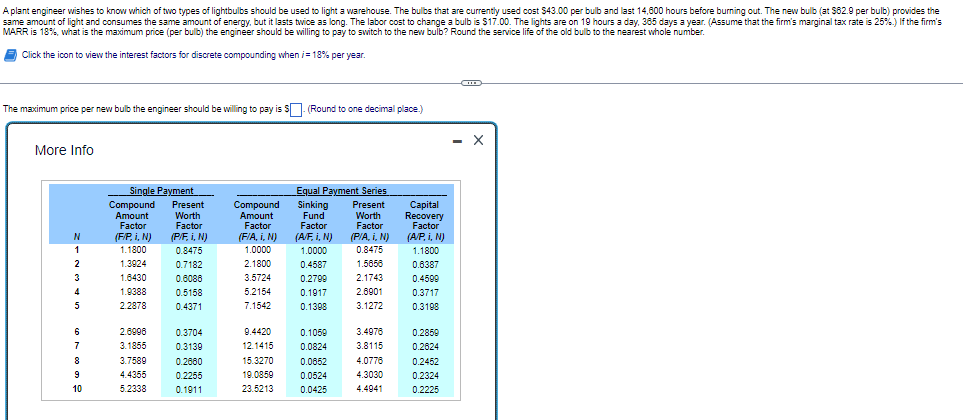A plant engineer wishes to know which of two types of lightbulbs should be used to light a warehouse. The bulbs that are currently used cost $43.00 per bulb and last 14,800 hours before burning out. The new bulb (at $82.9 per bulb) provides the same amount of light and consumes the same amount of energy, but it lasts twice as long. The labor cost to change a bulb is $17.00. The lights are on 19 hours a day, 365 days a year. (Assume that the firm's marginal tax rate is 25%) If the firm's MARR is 18%, what is the maximum price (per bulb) the engineer should be willing to pay to switch to the new bulb? Round the service life of the old bulb to the nearest whole number. Click the icon to view the interest factors for discrete compounding when i=18% per year. The maximum price per new bulb the engineer should be willing to pay is $- (Round to one decimal place.) X More Info Single Payment Equal Payment Series Present Compound Amount Factor Sinking Fund Factor Worth Factor Capital Recovery Factor (A/P, i, N) (F/A, i, N) (A/F, i, N) (P/A, i, N) 1.0000 1.0000 0.8475 1.1800 2.1800 0.4587 1.5658 0.6387 212 N 2 Compound Amount Factor (FP, i, N) 1.1800 1.3924 Present Worth Factor (P/F, i, N) 0.8475 0.7182
A plant engineer wishes to know which of two types of lightbulbs should be used to light a warehouse. The bulbs that are currently used cost $43.00 per bulb and last 14,800 hours before burning out. The new bulb (at $82.9 per bulb) provides the same amount of light and consumes the same amount of energy, but it lasts twice as long. The labor cost to change a bulb is $17.00. The lights are on 19 hours a day, 365 days a year. (Assume that the firm's marginal tax rate is 25%) If the firm's MARR is 18%, what is the maximum price (per bulb) the engineer should be willing to pay to switch to the new bulb? Round the service life of the old bulb to the nearest whole number. Click the icon to view the interest factors for discrete compounding when i=18% per year. The maximum price per new bulb the engineer should be willing to pay is $- (Round to one decimal place.) X More Info Single Payment Equal Payment Series Present Compound Amount Factor Sinking Fund Factor Worth Factor Capital Recovery Factor (A/P, i, N) (F/A, i, N) (A/F, i, N) (P/A, i, N) 1.0000 1.0000 0.8475 1.1800 2.1800 0.4587 1.5658 0.6387 212 N 2 Compound Amount Factor (FP, i, N) 1.1800 1.3924 Present Worth Factor (P/F, i, N) 0.8475 0.7182
Managerial Economics: Applications, Strategies and Tactics (MindTap Course List)
14th Edition
ISBN:9781305506381
Author:James R. McGuigan, R. Charles Moyer, Frederick H.deB. Harris
Publisher:James R. McGuigan, R. Charles Moyer, Frederick H.deB. Harris
Chapter8: Cost Analysis
Section: Chapter Questions
Problem 8E
Related questions
Question
15

Transcribed Image Text:A plant engineer wishes to know which of two types of lightbulbs should be used to light a warehouse. The bulbs that are currently used cost $43.00 per bulb and last 14,800 hours before burning out. The new bulb (at $82.9 per bulb) provides the
same amount of light and consumes the same amount of energy, but it lasts twice as long. The labor cost to change a bulb is $17.00. The lights are on 19 hours a day, 365 days a year. (Assume that the firm's marginal tax rate is 25%.) If the firm's
MARR is 18%, what is the maximum price (per bulb) the engineer should be willing to pay to switch to the new bulb? Round the service life of the old bulb to the nearest whole number.
Click the icon to view the interest factors for discrete compounding when i = 18% per year.
COO
The maximum price per new bulb the engineer should be willing to pay is S. (Round to one decimal place.)
More Info
Single Payment
Equal Payment Series
Compound
Amount
Factor
(F/A, i, N)
Sinking
Fund
Factor
Present
Worth
Factor
Capital
Recovery
Factor
(A/P, i, N)
(A/F, i, N)
(P/A, i, N)
1.0000
1.0000
0.8475
1.1800
2.1800
0.4587
1.5658
0.6387
3.5724
0.2799
2.1743
0.4599
5.2154
0.1917
2.8901
0.3717
7.1542
0.1398
3.1272
0.3198
9.4420
0.1059
3.4978
0.2859
12.1415
0.0824
3.8115
0.2624
15.3270
0.0652
4.0776
0.2452
19.0859
0.0524
4.3030
0.2324
23.5213
0.0425
4.4941
0.2225
N
1
2
3
4
5
6
7
8
9
10
Compound
Amount
Factor
(F/P, i, N)
1.1800
1.3924
1.6430
1.9388
2.2878
2.6996
3.1855
3.7589
4.4355
5.2338
Present
Worth
Factor
(P/F, i, N)
0.8475
0.7182
0.6086
0.5158
0.4371
0.3704
0.3139
0.2680
0.2255
0.1911
X
Expert Solution
This question has been solved!
Explore an expertly crafted, step-by-step solution for a thorough understanding of key concepts.
This is a popular solution!
Trending now
This is a popular solution!
Step by step
Solved in 2 steps

Knowledge Booster
Learn more about
Need a deep-dive on the concept behind this application? Look no further. Learn more about this topic, economics and related others by exploring similar questions and additional content below.Recommended textbooks for you

Managerial Economics: Applications, Strategies an…
Economics
ISBN:
9781305506381
Author:
James R. McGuigan, R. Charles Moyer, Frederick H.deB. Harris
Publisher:
Cengage Learning

Managerial Economics: Applications, Strategies an…
Economics
ISBN:
9781305506381
Author:
James R. McGuigan, R. Charles Moyer, Frederick H.deB. Harris
Publisher:
Cengage Learning